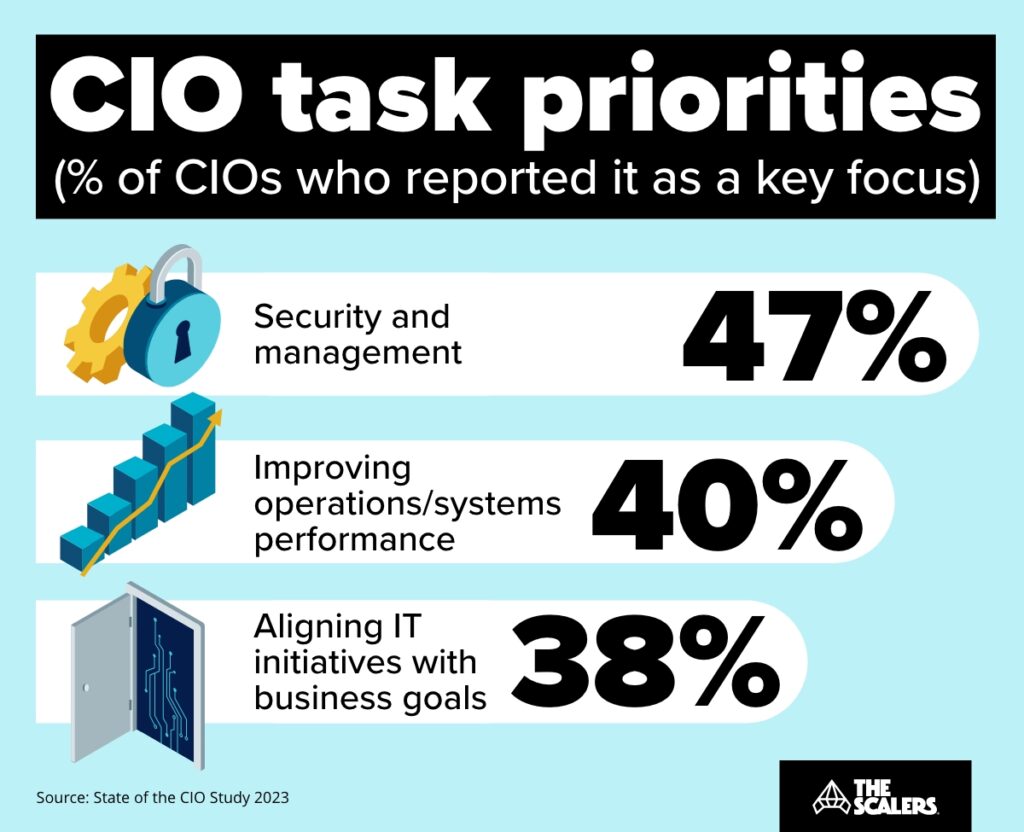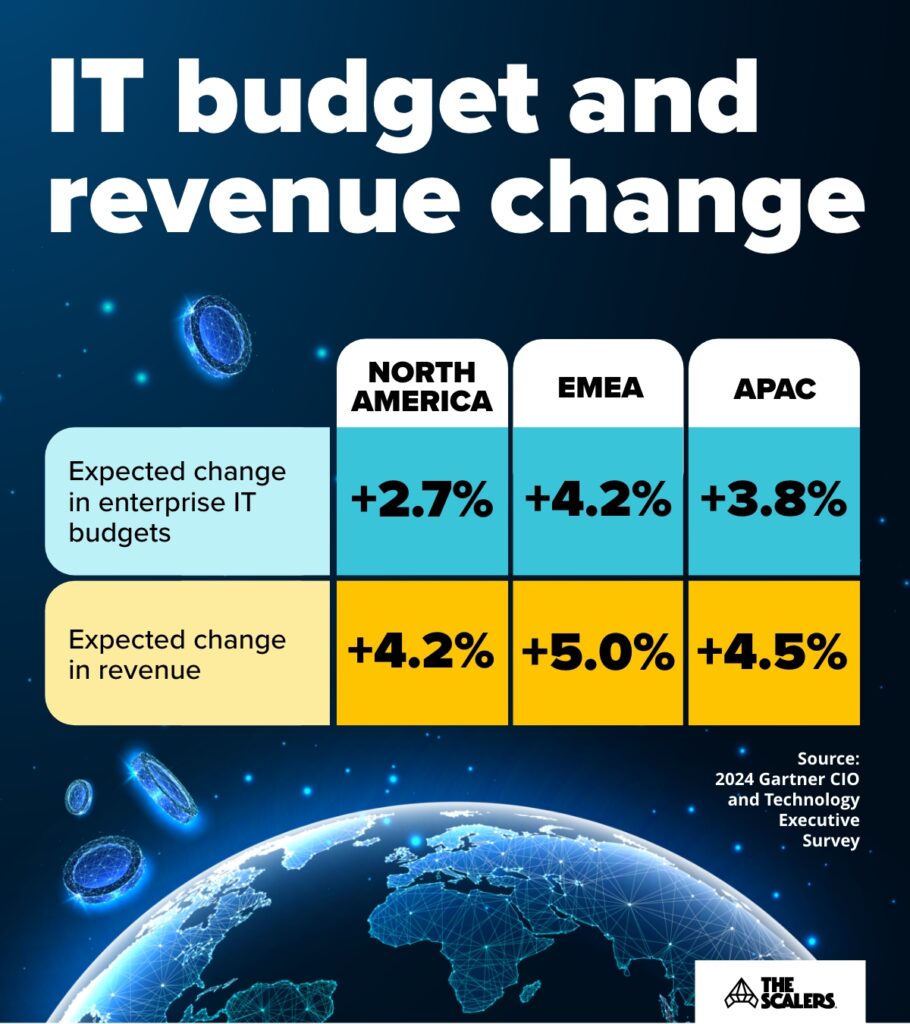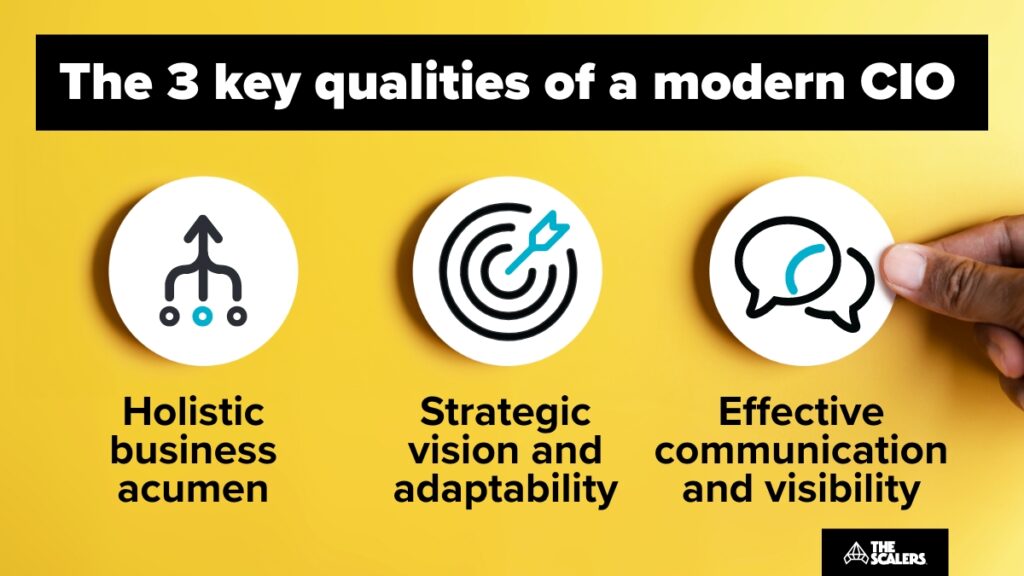The Chief Information Officer (CIO) may be a (relatively) recent addition to organisational structures, but its impact has been profound.
And its significance is growing.
Today, CIOs are more than just IT operators. They’re business leaders who drive competitive advantage to businesses and make strategic decisions, such as setting up an offshore development centre to scale dev teams with elite talent.
In this article, we’ll discuss the evolving role of the CIO from its early days to its crucial impact on an AI-driven future. After reading it, you’ll know the CIO’s role timeline, the challenges they face, and the qualities a modern CIO should possess.
Let’s get started!
What is a CIO?
A CIO is the C-level executive responsible for overseeing the selection, construction, deployment, monitoring, and maintenance of IT assets in an organisation.
CIOs typically occupy the highest tech leadership role in a company’s hierarchy. Over the past decades, their role has become essential, so they now manage functions beyond IT.
The term ‘CIO’ was first coined in 1981 in the book Information Resource Management by William R. Synnott, former Senior Vice President of Bank of Boston, and William H. Gruber, a former professor at the Massachusetts Institute of Technology.
The changing role of the CIO over the years
The CIO’s responsibilities have evolved from the 1980s to today, strengthening its position as a key player in companies of all sizes and industries.
CIOs in the 1980s
Before the 80s, CIOs didn’t exist. There were only IT managers.
Once the role was officially born, CIOs were considered company tech experts, handling IT infrastructure during a time when computing was centralised.
CIOs in the 1990s
In the 90s, CIOs became big players in business strategy.
With more decentralised IT, they focused on streamlining processes and making efficient information systems for global operations.
CIOs in the 2000s
ERP (Enterprise Resource Planning) and social information systems dominated the 2000s.
CIOs evolved to implement communication-enhancing systems and engage in strategic conversations with vendors. The focus expanded from information systems to encompass broader business solutions.
CIOS in the 2010s
In the 2010s, CIOs became “technology architects”, understanding the organisation’s holistic structure amid the rise of agile, distributed teams, and cloud computing.
CIOs in the 2020s (and the upcoming AI era)
Today, CIOs are dealing with hefty workloads.
Among other responsibilities, they ensure IT works well, keep data transparent, plan digital changes, build world-class tech teams, encourage innovation, and handle cybersecurity.
Plus, with the AI boom, they are expected to establish a roadmap to help their organisations navigate the new tech revolution.

The 3 critical CIO challenges today
Now that we’ve discussed the evolving role of the CIO in the past decades, it’s time to talk about the main challenges these tech leaders face (and will face) in the coming years.
Securing top talent
Finding, building, and nurturing a high-performing tech team is integral to the success of any modern CIO. It involves identifying and recruiting individuals with the right technical expertise and soft skills required to collaborate effectively within the organisation.
However, the worrying tech talent scarcity in Western countries has turned what once was an exciting task into a daunting one.
The skill shortage in the UK and other Western countries is making CIOs turn their heads overseas to search for talent they can’t find at home. While offshoring has been an excellent solution to scarcity for years, its popularity has grown and will continue to do so.
Especially with the rise of a modern approach to offshoring known as Offshoring 2.0.
Optimising budget
Budget constraints and financial limitations remain persistent headaches for CIOs.
The reason? Other C-level executives ask them to support their companies’ growth initiatives while reducing costs as much as possible.
It’s no surprise that organisations are adopting a conservative investment posture in the short term. Global growth will likely slow to 2.6% next year, with economists saying there’s a possibility of ‘mild recessions’ in Europe and the UK.
In such circumstances, CIOs must explore cost-effective solutions and develop strategies to optimise existing resources without compromising the quality and security of IT operations.
As shown in the infographic below, CIOs predict smaller budget increases than expected revenue increases from 2023 to 2024. This means they may have to handle increasing demand while improving efficiency.

Fostering innovation and embracing AI
The rapid integration of AI presents multiple challenges for CIOs. Transitioning to the first truly scaled deployment of AI in the enterprise is one of the most ambitious ones.
Tech leaders will now have the task of training foundational AI models (a form of generative AI) with their company’s unique data. GPT-4 — OpenAI’s latest large language model available via ChatGPT — is an example of a foundational AI model.
CIOs can gain key business insights, improve operational efficiency, and make strategic decisions by training these models, as generative AI uses algorithms to predict and analyse patterns.
The 3 traits of a successful CIO in the AI era (and beyond)
As emphasised in the article, a CIO’s responsibilities extend beyond tech management. It’s a position that demands a set of non-technical skills.
Here are the three main attributes defining today’s and tomorrow’s CIOs.

Holistic business acumen
Business acumen is the ability leaders have to connect the dots (and see the bigger picture) in and outside their organisation.
A CIO with business acumen understands who’s doing what in the company, how departments work together and what strategy would work best for achieving results and adding value to the business.
In the AI era, as exciting and unpredictable as it is, CIOs will need to dive deep into their organisations’ structures and know their customers well. Those who lead teams embracing automation, staying updated on trends, and using strong data skills to predict future business needs will prevail.
Strategic vision and adaptability
Successful CIOs think strategically and have a broad perspective encompassing all aspects of the organisation.
They analyse how IT decisions affect the business, consider the return on investment, and address team needs. The modern CIO finds, uses, and adapts the right processes to help the company thrive while embracing disruptive thinking, as technology often challenges traditional ways.
Effective communication and visibility
CIOs must communicate well and be transparent in their leadership to build trust with peers and critical stakeholders.
As well, being visible is essential both within and outside the company. Serving as a visionary voice contributes to recognition and impacts the organisation’s success.
For example, a CIO could write articles for well-known sites like Forbes, join industry podcasts, and attend key conferences. This not only displays their expertise but also boosts the company’s reputation in the business community.
Final thoughts on the evolving role of the CIO
In the past 40 years, CIOs have gone from mere techies to respected executives leading organisations’ growth strategies.
With new technologies — such as AI — changing industries and bringing new challenges, their role will become even more essential and continue to evolve.
Key takeaways:
-
1
The CIO is a pivotal C-level executive responsible for the comprehensive oversight of IT assets in an organisation.
-
2
The CIO has evolved from a tech expert in the 1980s to a strategic business leader in the AI era, playing a crucial role in making tactical decisions.
-
3
CIOs face challenges such as securing top talent amid tech talent scarcity, optimising budgets while supporting growth initiatives, and navigating the integration of AI for scaled deployment.
-
4
Successful CIOs today (and in the future) exhibit holistic business acumen, strategic vision, and adaptability while prioritising effective communication and external visibility.
If you’ve found this article on the evolving role of the CIO interesting and are looking to scale your dev team with elite talent, we’re happy to help you.
At The Scalers, we build top software development teams in Bangalore, India, a tech hub known as ‘The Silicon Valley of Asia’. Contact us, and one of our senior team members will assist you and answer any questions you may have.
Build Your Team,
Not Just a Contract
With The Scalers’ offshore dedicated development team, you get engineers who join your workflow for the long run. Grow steadily, stay flexible, and work with people who care about the product as much as you do.








